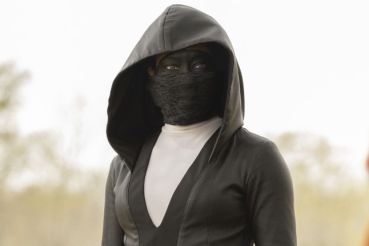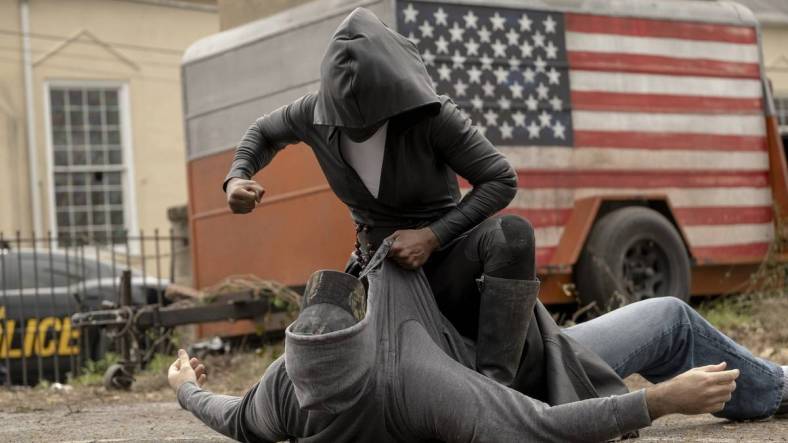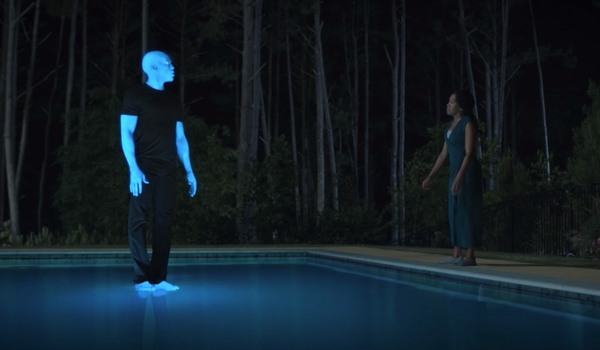Over the Juneteenth weekend, HBO offered the Watchmen TV show for free. It’s a  continuation of the movie, based on the comic book by Alan Moore. Alan Moore hated the movie and he’s pretty bitter about the TV show. There is not an Alan Moore adaptation that Alan Moore can stomach. You can’t judge how good an adaptation is by how much Moore hates it, though, I would argue that he isn’t wrong. As problematic Alan Moore’s work can be (sometimes intentionally and sometimes, like his treatment of women, unintentionally), somehow in adaptation it gets more problematic.
continuation of the movie, based on the comic book by Alan Moore. Alan Moore hated the movie and he’s pretty bitter about the TV show. There is not an Alan Moore adaptation that Alan Moore can stomach. You can’t judge how good an adaptation is by how much Moore hates it, though, I would argue that he isn’t wrong. As problematic Alan Moore’s work can be (sometimes intentionally and sometimes, like his treatment of women, unintentionally), somehow in adaptation it gets more problematic.
I was worried Watchmen would be another Joker, an adaptation stripped of complexity and boiled down to some simple aphorism that was appealing to angry white men. Or, worse, it would go the way of Scar Face, American History X, Fight Club, and American Psycho where the folks most into the movie are people who seem to have missed the biting satire and confused irony with glorification.
My friend Adam, who is about five times better a feminist than I am told me it was very good. So I watched it.

First, the Tulsa “race riot” scenes are breath taking. I had seen a documentary including the surveying of mass graves several years ago. I knew the history enough to know exactly how not over the top it was. White folks did bomb Black Wall Street from the air. The attention to detail was amazing. Most of the white men murdering blacks left and right were deputized. They were engaging in the slaughter under the official ok of the sheriff.
Each time the TV show touched on history, or the fears a cop has making a traffic stop, or the danger of white nationalists the show rings true.
 Which is what makes Sister Night such a powerful character and such a problematic one. Early on Sister Night is shown beating information out of a suspect. It’s a pattern that repeats. And, as American entertainment consumers, I’m certain most people didn’t bad an eyelash. In the movies, books, and TV, police and the military regularly use torture to gain important life saving information. And, Watchman is no different. The information obtained turns out to be true and actionable.
Which is what makes Sister Night such a powerful character and such a problematic one. Early on Sister Night is shown beating information out of a suspect. It’s a pattern that repeats. And, as American entertainment consumers, I’m certain most people didn’t bad an eyelash. In the movies, books, and TV, police and the military regularly use torture to gain important life saving information. And, Watchman is no different. The information obtained turns out to be true and actionable.
Here is the problem. Torture doesn’t work that way in real life. Study after study reveals that torture (or “enhanced interrogation techniques” for those who think changing the words somehow magically changes the action) rarely works. When exposed to pain the vast majority of people will say anything and everything to make it stop, including things that aren’t true. Detainees will make things up if they think that is what their interrogators want, sometimes not even aware they are confabulating.

You could argue, in a show where there are no heroes, just like the OG Watchman comic, showing Sister Night’s cavalier attitude about torture is a way to demonstrate that even the hero of the story is not a “good guy.” And that would be fine, if the torture didn’t work. But because it does work, it becomes a tool the character uses instead of a signifier of the brokenness of the process.
In the last 30 years I think I’ve only ever seen one TV show or movie that has the “good guys” using torture that accurately reflects reality. Spoilers: season one of Battlestar Galactica , Flesh and Bone, we have a capture Cylon terrorist who claims they have a ticking time bomb. The good guys torture him for information on where the bomb is and get information–false information.
I don’t know if this is a uniquely American thing, the conviction torture works. I’m guessing not as it is practiced legally and extra-legally by police around the world. Regardless, US media is swimming in the idea.
In reality, an effective interrogation is much more like “The Closer”. The interrogator builds a rapport. They tell the prisoner things to reassure the captive that the interrogator is on their side. Maybe they get the prisoner something the prisoner shouldn’t have (“a special favor”). A skillful interrogation more closely models what happens in Stockholm Syndrome where the captive begins to identify with the captor. In the end, the prisoner turns over information because they want to, not out of fear. Unlike in “The Closer”, though, this takes time. It also makes for boring television.
This begins my spoiler section of my posting. If you haven’t seen Watchmen and care about spoilers. STOP. Stop reading right here.
This brings us back to the problem with Sister Night. She is a cop who works within a system where torture is deemed acceptable. She is not a good guy. Oh, she’s painted as a good person. We see her as a mother. Her personal traumas are shared with us in sympathetic ways. We watch her chase down the real bad buys even when they turn out to be the good guys. We mostly see her out of costume as Angela.
You might say, “What about her conversation with Hooded Justice where he tells her to let go of the anger?” Yes, that conversation happened. And certainly Hooded Justice has had his epiphany (not, of course, before murdering people himself). But did she earn redemption for her evil acts? Not really. She simply nods along with Hooded Justice as he completes his character arc. Despite sharing pre-epiphany memories, his redemption is not hers by default.
Doctor Manhattan warns that anyone who would want his power would be inherently untrustworthy. Yet, he gives her the vehicle by which to gain that insane, world smashing power. The same power she had fought so hard to keep out of the hands of those who would make the world in their own image. This power is entrusted into the hands of a woman who tortures people for information (and had done so just that night).
untrustworthy. Yet, he gives her the vehicle by which to gain that insane, world smashing power. The same power she had fought so hard to keep out of the hands of those who would make the world in their own image. This power is entrusted into the hands of a woman who tortures people for information (and had done so just that night).
I can hope the creators are thinking it through. Maybe a second season will explore the problem of someone who has spent years running around under a mask, who tortures people for information, and what taking on the terrible and unhealthy power of Doctor Manhattan would do. That shouldn’t be a good ending. Yet, our final scene shows Sister Night walking on water like Doctor Manhattan and Jesus.

If they don’t, at least you can start approaching depictions of torture with a more critical eye. When torture is used in media, ask yourself a few quick questions:
- Is the torture being depicted as entertainment?
- Is the torture being depicted realistically?
- Is torture being used to dehumanize the “bad guy”?
- Is torture yielding unrealistic results?
- Is this a lazy way for a writer to move the plot along quickly?

Oh, and if someone hands you a raw egg with omnipotent power, just say no.